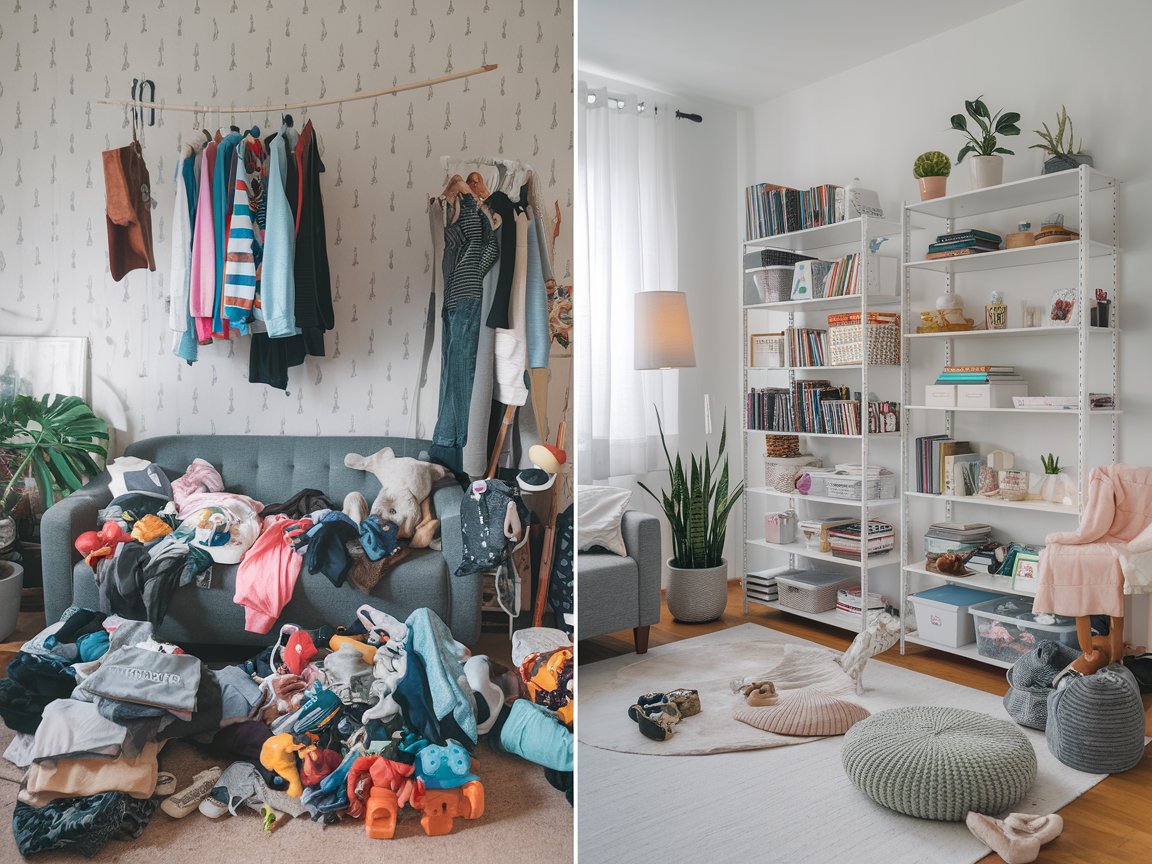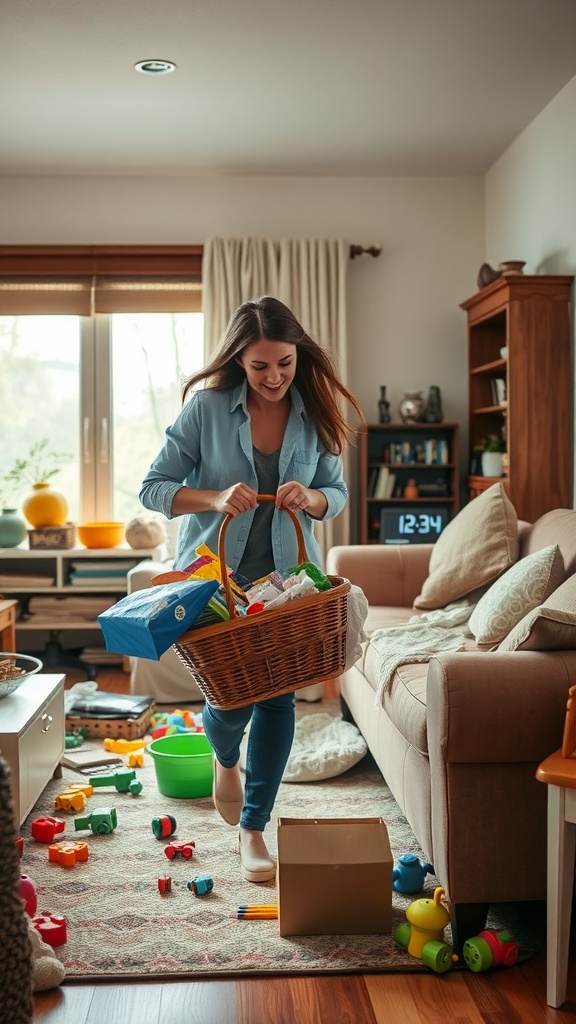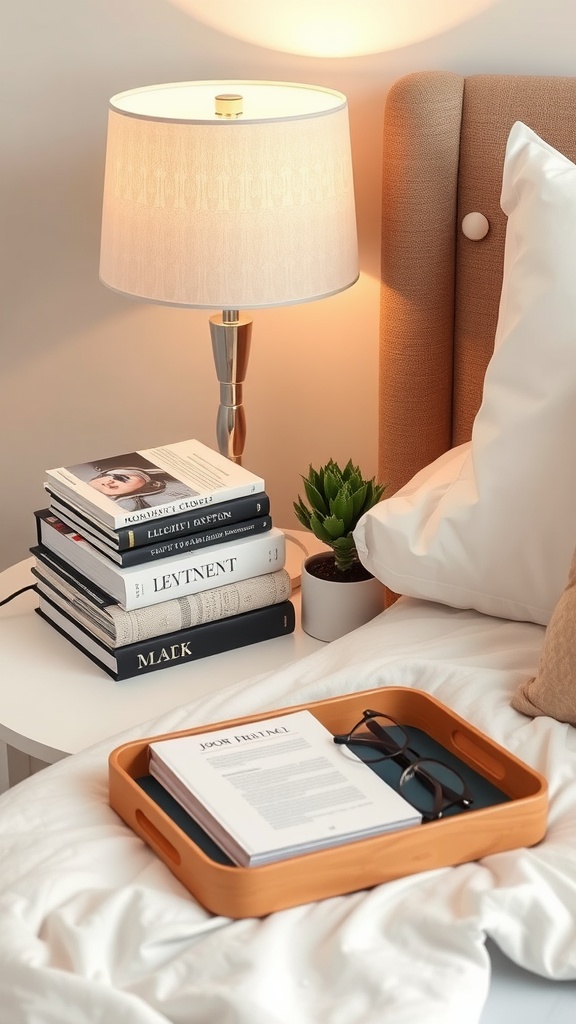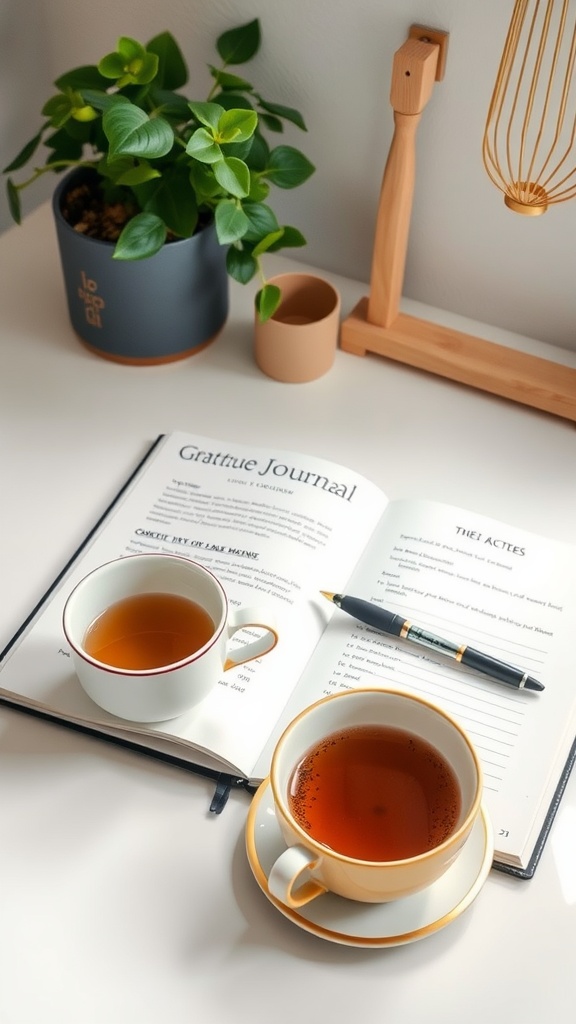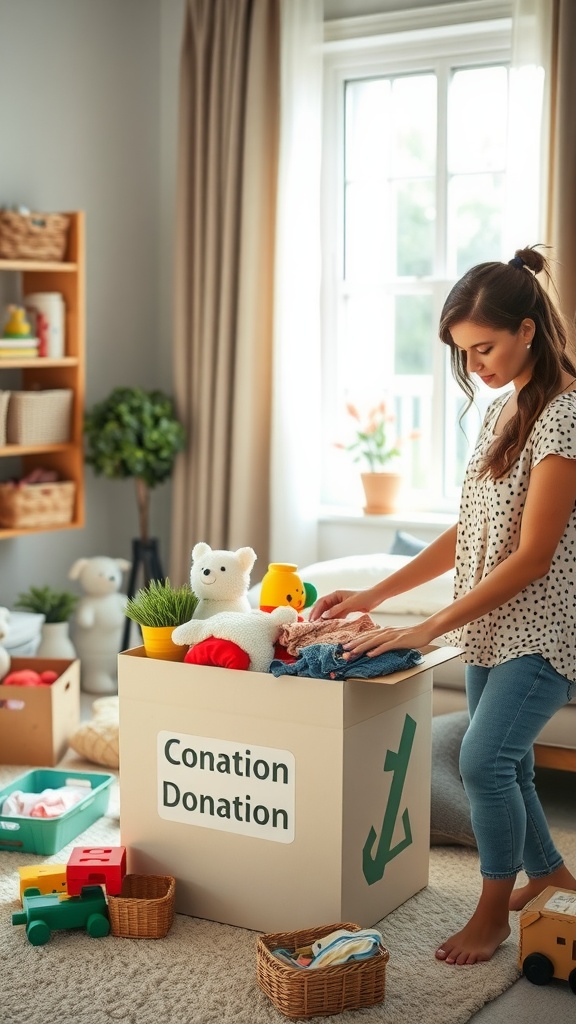Discover 25 easy decluttering tips designed for busy moms to help keep your home and mind organized — even on the go!
Being a mom often feels like living in organized chaos — except, let’s be real, sometimes the “organized” part gets lost in the shuffle! Between school drop-offs, grocery runs, and everything else on our plates, finding time to declutter can feel impossible. But clearing out that clutter doesn’t have to be overwhelming or time-consuming. These 25 easy tips are designed to fit into your busy schedule, giving you simple strategies to keep your home (and your mind) a little less chaotic.
And remember, decluttering your space is just one part of self-care. Take a moment to nourish your body, mind, and soul by checking out The Busy Mom’s Guide to Self-Love.
Section 1: Quick Wins for Everyday Decluttering
Decluttering doesn’t have to be a huge task. Start small by setting a timer for just 10 minutes and tackle one area, like a drawer or a shelf. These quick wins can make a big difference and help you stay organized without feeling overwhelmed.
1. 5-Minute Declutter Blitz:
Set a timer for just five minutes and focus on clearing one small space. Choose a clutter hotspot like your kitchen counter or a desk. The short time frame keeps you from feeling overwhelmed while still making progress. You can even do this while waiting for water to boil or coffee to brew. Small efforts add up to big results when done regularly.
2. One In, One Out Rule:
For every new item that comes into your home, commit to letting go of something old. This keeps clutter from piling up and encourages mindful purchasing. Whether it’s clothes, toys, or kitchen gadgets, this simple rule helps maintain balance. Keep a donation box handy to make it easier. The result? A more manageable living space over time.
3. Declutter on the Go:
Sort through mail, your purse, or even your car while waiting at school pickup or during other short breaks. Take advantage of downtime to organize small areas. Keep a trash bag and donation bag in your car to quickly handle unwanted items. This way, decluttering becomes a seamless part of your day. You’ll stay ahead of the mess without carving out extra time.
4. Daily Hotspot Sweep:
Spend a few minutes each evening clearing key areas like countertops and entryways to prevent clutter build-up. These areas tend to attract random items throughout the day. Could you make it a family habit by assigning everyone a quick cleanup task? Consistency is key to keeping these spots tidy. A clean entryway can make your home feel more welcoming.
5. Declutter While Cleaning:
Dusting a shelf? Take the opportunity to remove items you no longer need. Cleaning becomes more efficient when you’re not working around unnecessary clutter. Use this time to assess whether items are useful or simply taking up space. Place unwanted items in a donation bin immediately. You’ll end up with a cleaner and more organized home.
Section 2: Kid-Friendly Decluttering Tips
Getting kids involved in decluttering can make it fun and easy. Use colorful bins to sort toys and art supplies together, turning it into a game. Celebrate their efforts with a little reward once the space looks tidy!
6. Toy Rotation System:
Store half the toys away and rotate them every few weeks to keep playtime fresh and clutter low. Kids often feel overwhelmed when they have too many toys. By limiting the number available at any one time, they can enjoy each toy more fully. Rotation also makes toys feel new again when they come back out. Plus, less clutter means easier clean-up.
7. Declutter Game:
Make it fun by challenging your kids to see who can find the most items to donate or toss in 10 minutes. Turn on upbeat music to keep the energy high. Offer a small reward or praise for their efforts. This makes decluttering feel like a game rather than a chore. It also teaches kids valuable lessons about organization and giving.
8. Label Bins for Kids:
Use picture labels to help little ones quickly see where their toys belong. This makes it easier for them to clean up independently. Clear, visual cues reduce confusion and speed up the process. You can involve your child in decorating the labels to make them more engaged. Over time, it encourages responsibility and organizational skills.
9. Clean-Up Songs:
Sing or dance while tidying up to make it more enjoyable for everyone. Choose a fun song that signals it’s time to clean. The upbeat tempo helps keep the mood light and the pace quick. Kids are more likely to participate when the task is fun. Create a playlist specifically for cleaning time. It turns tidying into a positive experience.
10. Seasonal Declutter Challenge:
Before birthdays or holidays, have your kids pick out toys they no longer play with to make room for new ones. Explain the importance of donating to children who may not have as much. Set a specific goal for how many items to declutter. Celebrate their generosity with a special treat or activity. This practice helps maintain manageable toy collections.
Section 3: Mom-Specific Decluttering Zones
Empty your purse once a week to toss out old receipts and organize essentials. Use small pouches to group similar items like makeup, snacks, or first-aid supplies. Keep only what you truly need daily. A clutter-free purse makes finding things faster and less stressful. It’s a small habit that saves time throughout your day.
11. Purse Declutter Routine:
Empty your purse once a week to toss out old receipts and organize essentials. Use small pouches to group similar items like makeup, snacks, or first-aid supplies. Keep only what you truly need daily. A clutter-free purse makes finding things faster and less stressful. It’s a small habit that saves time throughout your day.
12. Car Clutter Management:
Keep a small bin in the car for toys, wipes, and trash — empty it weekly to maintain order. Designate specific spots for necessities like tissues, hand sanitizer, and chargers. Encourage kids to take their belongings back inside after each trip. A tidy car makes errands and travel more pleasant. Regular maintenance prevents overwhelming messes.
13. Bathroom Declutter:
Sort through and toss expired products while organizing essentials by category. Use drawer dividers or bins to keep things organized. Store daily-use items within easy reach and less frequently used ones in higher spaces. Decluttering here makes your morning routine smoother. A neat bathroom creates a calming start to the day.
14. Closet Clean-Out:
If you haven’t worn it in a year, it’s time to let it go. Try the hanger trick: turn hangers backward, and if they’re still backward after a season, donate the item. Organize clothes by category for easy access. Keep a donation bag in your closet for quick purges. A streamlined wardrobe saves time getting dressed.
15. Nightstand Organization:
Limit nightstand clutter to essentials like a lamp, book, and water bottle. Clear away unnecessary items that accumulate over time. Use small trays or organizers for essentials like glasses or phone chargers. A tidy nightstand promotes better sleep by creating a calming environment. It also makes morning clean-ups easier.
Section 4: Decluttering for Busy Moms’ Mental Health
Use brain dumps to clear mental clutter and prioritize tasks. Write down everything on your mind, then categorize and tackle it step by step. This helps reduce anxiety and improves focus. Keeping a journal or planner can make this process even more effective. Regular brain dumps ensure you’re always on top of your to-do list.
16. Declutter Your Mind:
Use brain dumps to clear mental clutter and prioritize tasks. Write down everything on your mind, then categorize and tackle it step by step. This helps reduce anxiety and improves focus. Keeping a journal or planner can make this process even more effective. Regular brain dumps ensure you’re always on top of your to-do list.
17. Gratitude Practice:
As you declutter, take a moment to appreciate the things you truly value. Reflecting on what brings you joy helps clarify what’s important to keep. Gratitude shifts your mindset from scarcity to abundance. It also makes parting with unnecessary items easier. Embrace the practice for a more mindful decluttering experience.
18. Self-Care Moments:
Decluttering can be self-care when done mindfully and without pressure. Focus on creating a peaceful environment that supports your well-being. Set realistic goals and celebrate progress rather than perfection. Light candles or play soothing music during the process. Turn a chore into an act of care for yourself.
19. Intentional Purchasing:
Letting go of items you no longer need can bring a sense of freedom. Imagine the joy your donations could bring to someone else. Choose local charities or shelters to support your community. Remember that decluttering isn’t about waste but about redistributing resources. This perspective can make parting with items easier.
20. Mindful Donation:
Letting go of items you no longer need can bring a sense of freedom. Imagine the joy your donations could bring to someone else. Choose local charities or shelters to support your community. Remember that decluttering isn’t about waste but about redistributing resources. This perspective can make parting with items easier.
Section 5: Maintaining Long-Term Decluttering Success
To keep your space clutter-free, set a simple routine. Spend just a few minutes each day tidying up and putting things in their place. This small effort makes all the difference in maintaining a peaceful environment.
21. Set a Decluttering Routine:
Even dedicating 10 minutes a day to tidying up can make a big difference over time. Consistency is more important than duration. Choose a time of day that works best for you. Make it part of your daily routine, like right after dinner or before bed. Regular small efforts maintain a clutter-free home.
22. Keep Donation Bags Handy:
Place a bag in each room to collect items ready for donation. This encourages ongoing decluttering rather than waiting for a big clean-out. When the bag is full, drop it off at a donation center. Having designated donation spots makes the process seamless. It also keeps clutter from creeping back in.
23. One Room at a Time:
Focus on fully decluttering one space before moving on to the next. This prevents burnout and allows you to see tangible progress. Start with the room that causes you the most stress. Break the process into manageable sections if needed. Celebrate each completed room to stay motivated.
24. Declutter Digitally:
Delete old photos, apps, and files from your phone and computer. Organize essential files into labeled folders. Regularly clear out your email inbox to reduce overwhelm. Digital decluttering creates a smoother workflow and less mental clutter. It’s a crucial part of modern organization.
25. Celebrate Progress:
Every little step counts — reward yourself for your wins! Treat yourself to something you enjoy after completing a decluttering task. Acknowledge the effort you put in, even if it’s just 10 minutes. Positive reinforcement encourages you to keep going. Remember, progress is better than perfection.
Inspire Action:
Decluttering doesn’t have to be a stressful, all-day event. With small steps, you can regain control over your space and your peace of mind. Remember, you’re doing an amazing job! And while you’re on this journey, don’t forget to care for yourself. Check out 20 Self-Care Strategies for Moms for more ways to find balance and peace amid the beautiful chaos of motherhood.

